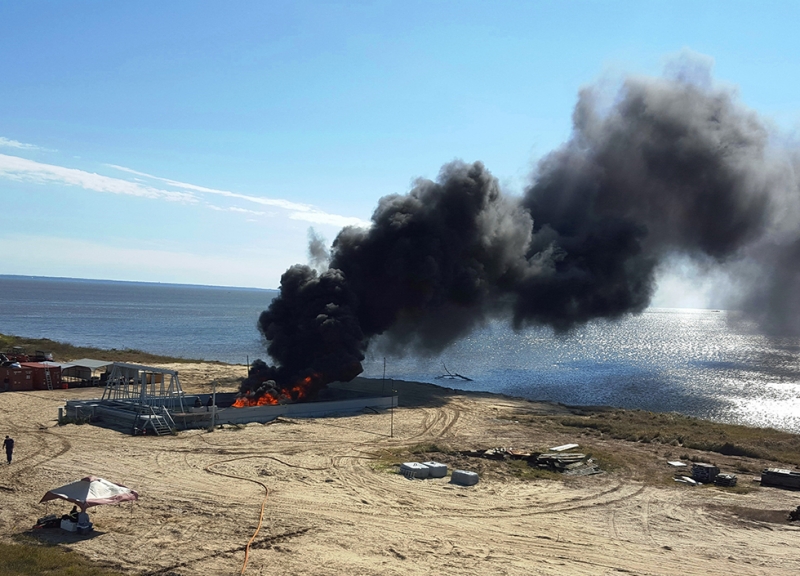
Recently, I had the privilege of joining folks from the United States Coast Guard (USCG) Research and Development Center as well as researchers from Bureau of Safety and Environmental Enforcement (BSEE) for a portion of a test burn conducted on Little Sand Island located at the mouth of the Mobile River in Alabama. Having participated in a successful in situ—controlled burn—at the Delta Wildlife Refuge back in June of 2014 with my colleagues from NOAA’s Emergency Response Division, I was eager to learn more about what research is being conducted in the field and jumped at the opportunity to see some of this testing being performed in my backyard, so to speak.
A little background on Little Sand Island
The Joint Maritime Test Facility (JMTF) in Mobile, Alabama, is a partnership between the Coast Guard Research and Development Center and the U.S. Navy’s Naval Research Laboratories. It is the only national federal testing facility for maritime fire protection research and includes the ex-USS Shadwell. Little Sand Island also has a refurbished test tank for large-scale oil burn testing and research.
Damaged during Hurricane Katrina in 2005, the facility figured prominently in past burn research and was recently resurrected with funding from Bureau of Safety and Environmental Enforcement (BSEE). The initial series of burn testing at the facility in the late ‘90s led to many advances in burn science, including the establishment of standards on fire resistant booms. Renewed interest of in situ burning (ISB) research has resulted in part from lessons learned from the Deepwater Horizon oil spill in 2010.
In situ burning was employed extensively during the spill and many viewed its role as critical in the overall spill response. Approximately 400 safe and effective controlled burns were conducted during the Deepwater Horizon spill, removing an estimated 220,000 to 310,000 barrels (29,700 to 41,800 tons) of oil from the water. According to the Oil Budget Calculator report provided to the National Incident Command in November 2010, approximately 50,000 to 70,000 barrels were burned in one day alone.
‘You don’t need a weather man to know which way the wind blows’
But it certainly helps if you want to know which way it is going to blow tomorrow when you are planning a burn. One of the key requirements for burning at the Little Sand Island facility is to ensure that smoke from the burn does not carry over the urban western side of the river, or north over the interstate where it could obscure visibility for motorists.
When the newly refurbished facility had its first test burn in November 2015, having support from the National Weather Service in Mobile during the planning and operational phases was important in determining when conditions on the island were favorable for burning.
Another benefit of planning a burn at a test facility is that other support conducted during an actual burn can also be planned. That was exactly the approach in November as members of the USCG Gulf Strike Team used the opportunity to deploy Special Monitoring of Applied Response Technologies, air monitoring equipment, at the facility. Although not a primary objective of the testing, we were able to use the opportunity to deploy the Strike Team as part of a practical exercise. Having the opportunity to plan and deploy the equipment in a realistic field setting and assessing actual results from a burn of a known quantity of oil was very beneficial both for the Strike Team and folks from the facility.
Latest research on the horizon
Now that the facility burn pan has had the ‘tires kicked’ so to speak and is ready for use, a number of research projects are planned and underway. USCG Research and Development is currently working with BSEE on two additional ISB research projects which will be conducted in part on Little Sand Island. The most recent testing included initial evaluation of an aggregate compound made from pine saw dust and a fatty acid binding agent. This material is designed to help burn oil in layer thickness ranges that are otherwise too thin to sustain a burn. Additional testing at the facility is scheduled for this spring. Hopefully, I will have the opportunity to join in as the testing continues.
Adam Davis serves as NOAA Scientific Support Coordinator for U.S. Coast Guard District 8 and NOAA’s Gulf of Mexico Disaster Response Center. He graduated from the University of Alabama at Birmingham before entering the United States Army where he served as a nuclear, biological, and chemical operations specialist. Upon completing his tour in the Army, Adam returned home and completed a second degree in environmental science at the University of West Florida. He comes with a strong background in federal emergency and disaster response and has worked on a wide range of contaminant and environmental issues. He considers himself very fortunate to be a part of NOAA and a resident of the Gulf Coast, where he and his family enjoy the great food, culture, and natural beauty of the coast.
